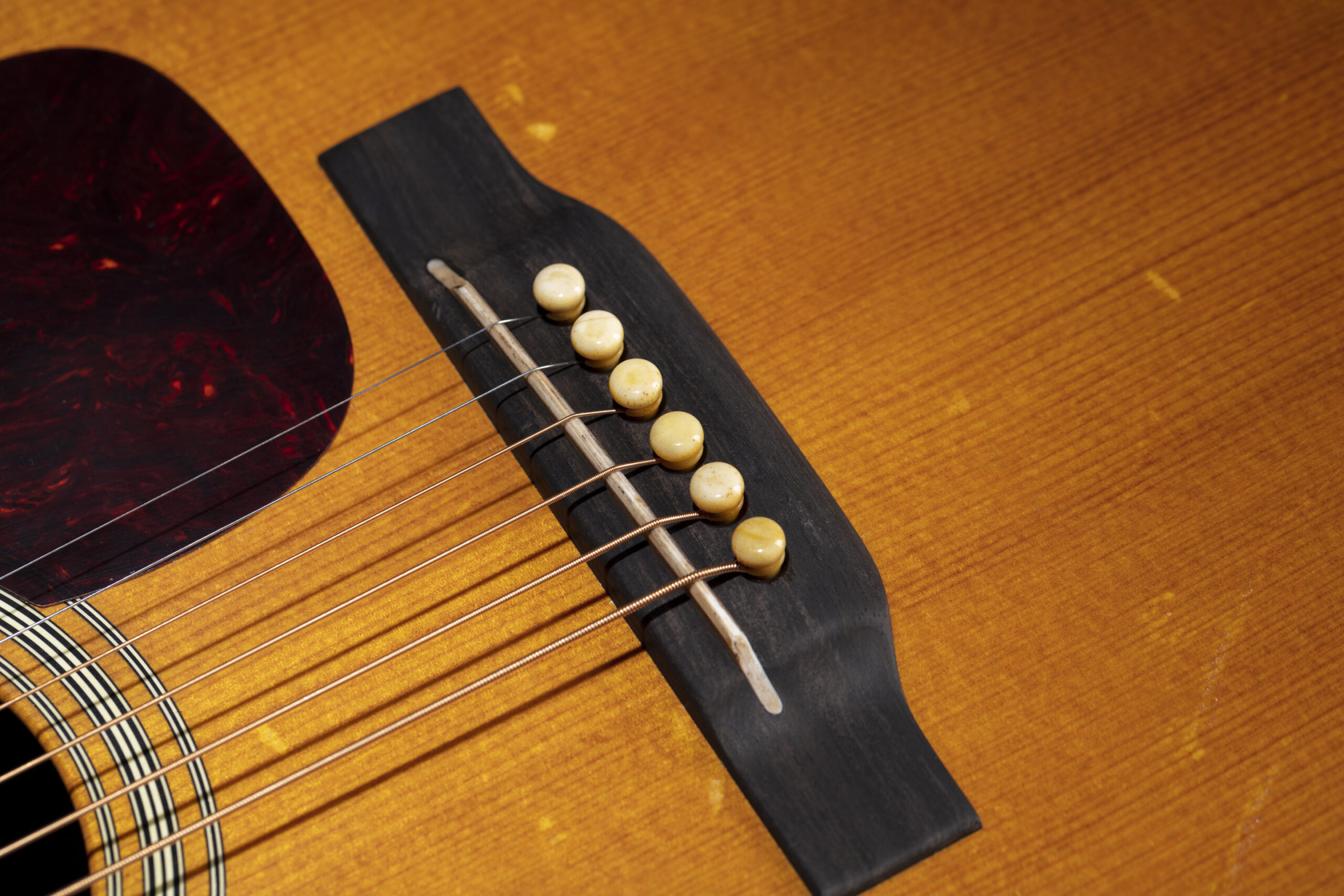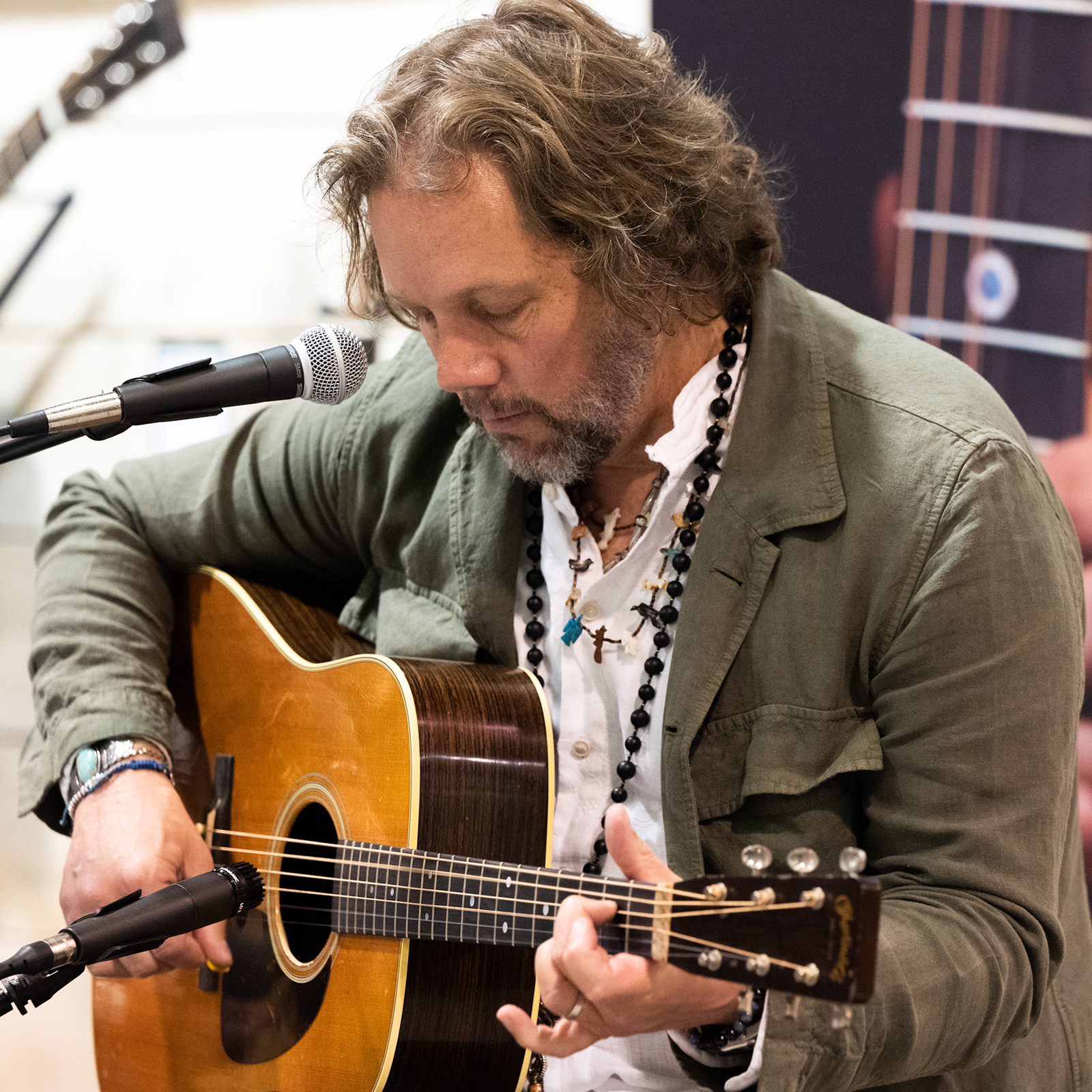The fabled 1954 D-28 of the Black Crows’ Rich Robinson recreated
Martin’s Aged cosmetics and rearward-shifted bracing recreate a 1950s Martin cannon
D-28 Rich Robinson Specs include: All-solid tonewood construction with hot hide glue construction; 14-fret Dreadnought body size; Indian rosewood back and sides; spruce soundboard with Style 28 black and white ply purfling and rosette, Antique toner; 5/16” non-scalloped, rearward-shifted top bracing; Genuine Mahogany neck with 1954 heel and shaping unique to this model, dark mahogany stain; Ebony fingerboard with large mother of pearl dot markers, 1-11/16” width at the bone nut; Ebony bridge with smooth contour and long drop-in bone saddle with 2-1/8” string spacing; Vintage Gloss back, side, and top finish with Authentic-style Aged cosmetic distressing on the body, neck, and headstock; faux tortoise shell pickguard; Antique White body binding; Golden Era script headstock logo on an Indian rosewood faceplate; Aged enclosed tuning machines with oval buttons; retro molded blue plastic case.
“…this is a full-throated thoroughbred Martin. The coupling of that immediate fundamental pop to the languid swell of the undertone, finished off by those complex, hovering and angelic harmonic overtones makes for a voice that is, in a word, delicious.”
The First Aged Artist Edition
The Martin D-28 Rich Robinson is a 14-fret Dreadnought size acoustic guitar made in a version of Style 28 used in the 1950s. It is a close approximation to the 1954 D-28 owned and played by Rich Robinson of the Black Crowes. Robinson composed many of the Black Crows’ most memorable songs on that guitar and it had many more years of playing before he took possession of it from his dad, Stan Robinson, who performed as a member of Hillbilly Highway and the Appalachians, and who played that guitar at the Grand Ole Opry.
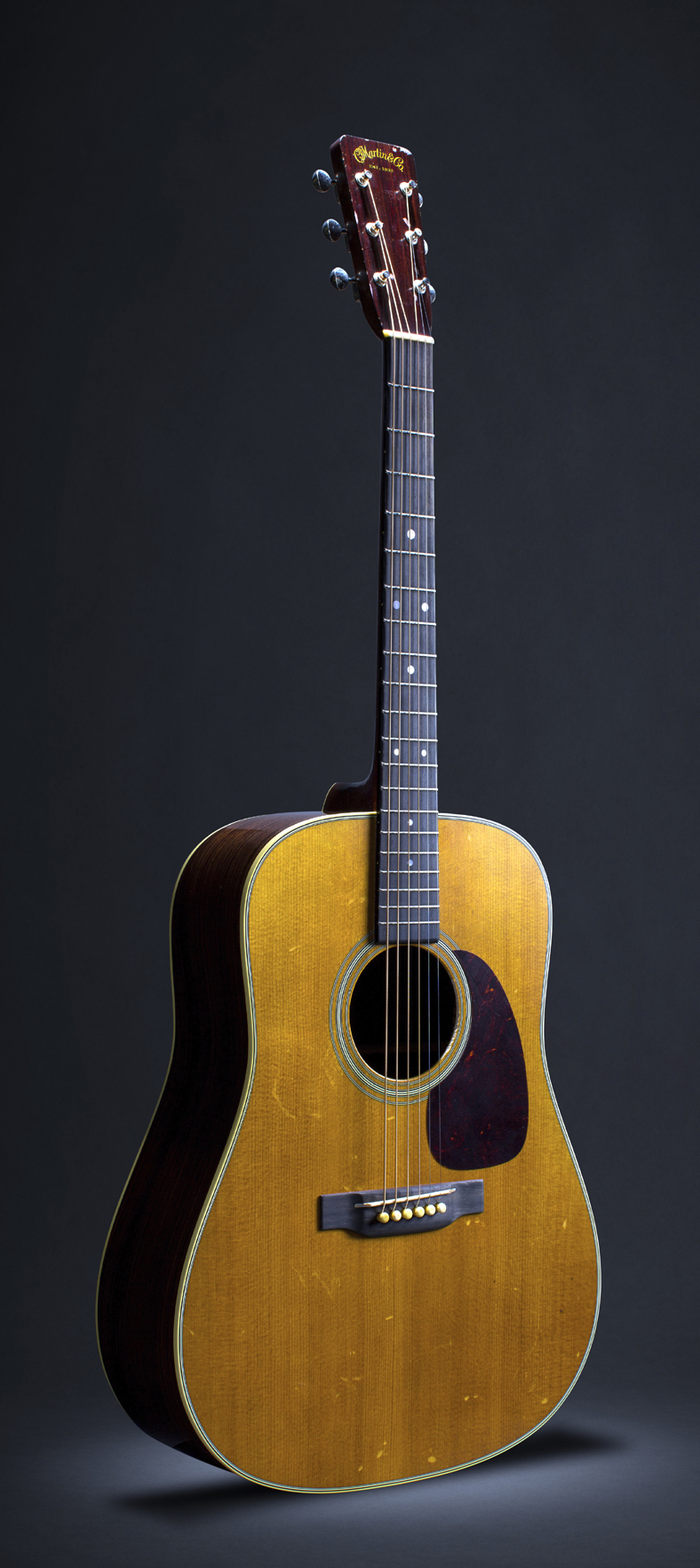
It is a well-traveled and well-storied Martin, with the visual evidence exhibited on its 69-year-old spruce top, having acquired various nicks and dings and scratches in the patina of the well-seasoned finish on the headstock and rosewood back and sides. And the new signature model emulates that vintage Martin look, through some exquisite cosmetic techniques that replicate decades of seasoning.
This is the first time Martin has applied their exclusive aging techniques to an artist signature model. Just like the close replication of the exact neck shape from Robinson’s vintage Martin, the “Aged” cosmetic appointments have normally been reserved for the elite Authentic Series instruments.
This signature model doesn’t just have the trim and fret markers of a 1954 Martin, it actually looks like a vintage Martin in terms of the condition of the finish, the color of the side dots on the neck, and other detailing. When Tim Teel opened a guitar case in the Martin Museum and handed me the prototype of the D-28 Rich Robinson, I thought I was about to play an actual vintage Martin recently acquired for the museum. If it did not have a label visible from inside the body, most anyone would assume it was truly a 1950s D-28 that had a long career.
While it looks like a 1950s Martin in every detail, there is also a very special feature on this guitar that helped 1950s Martins sound the way they do. It is built with non-scalloped, reward-shifted bracing!
A Boomer’s Boomer
While the post-WWII Baby Boom was going on in the late 1940s and 1950s, Martin was handcrafting dreadnoughts with powerful voices that earned the nickname Bluegrass Cannons. The soundboard bracing used at the time helped create a sound both loud and articulate. That is an apt description of the sound produced by this new artist signature model.
Pre-1938 dreadnought bracing had the X-brace intersection placed about 1 inch from the edge of the sound hole. Post 1959 bracing has that moved farther back. The X-brace placement used from 1939 to 1959 was even farther back from the sound hole, which is now referred to as reward-shifted bracing.
What really matters here is how close the X-brace intersection is from the bridge plate. Rearward-shifted bracing makes the top near the bridge plate stiffer, resulting in less vibration as energy passes through the bridge, bridge plate, top, and bracing. Rear-shifted, non-scalloped braces result in a voice with focused articulation in the fundamental voice, while still having the desired warmth and harmonic complexity of a classic rosewood Martin.
I loved playing this instrument. It felt like I was in command of a Harley Davidson that purred thickly and roared effortlessly. The most noticeable difference between this guitar and other modern Martins is how clear and present are the bass notes. Be it a strummed chord, with each note standing up out with its own identity as if the strum was somehow made of chord-uroy, or a run of lead guitar, the E and A string report with immediate presence.
Fretted treble notes ignite soaring sympathetic tones from deep inside the cavernous body that glisten with pure tone. The resonating tone in the higher harmonics hang in space and waver slowly, as if expanding inside a cathedral. But the voice also has that rich, warm cushion of undertone behind the entire voice that I so love from an Indian rosewood dreadnought with a good piece of North American spruce on top. It is is not as echoing and ethereal as one gets from from forward-shifted, scalloped bracing. It is somehow denser, firm even.
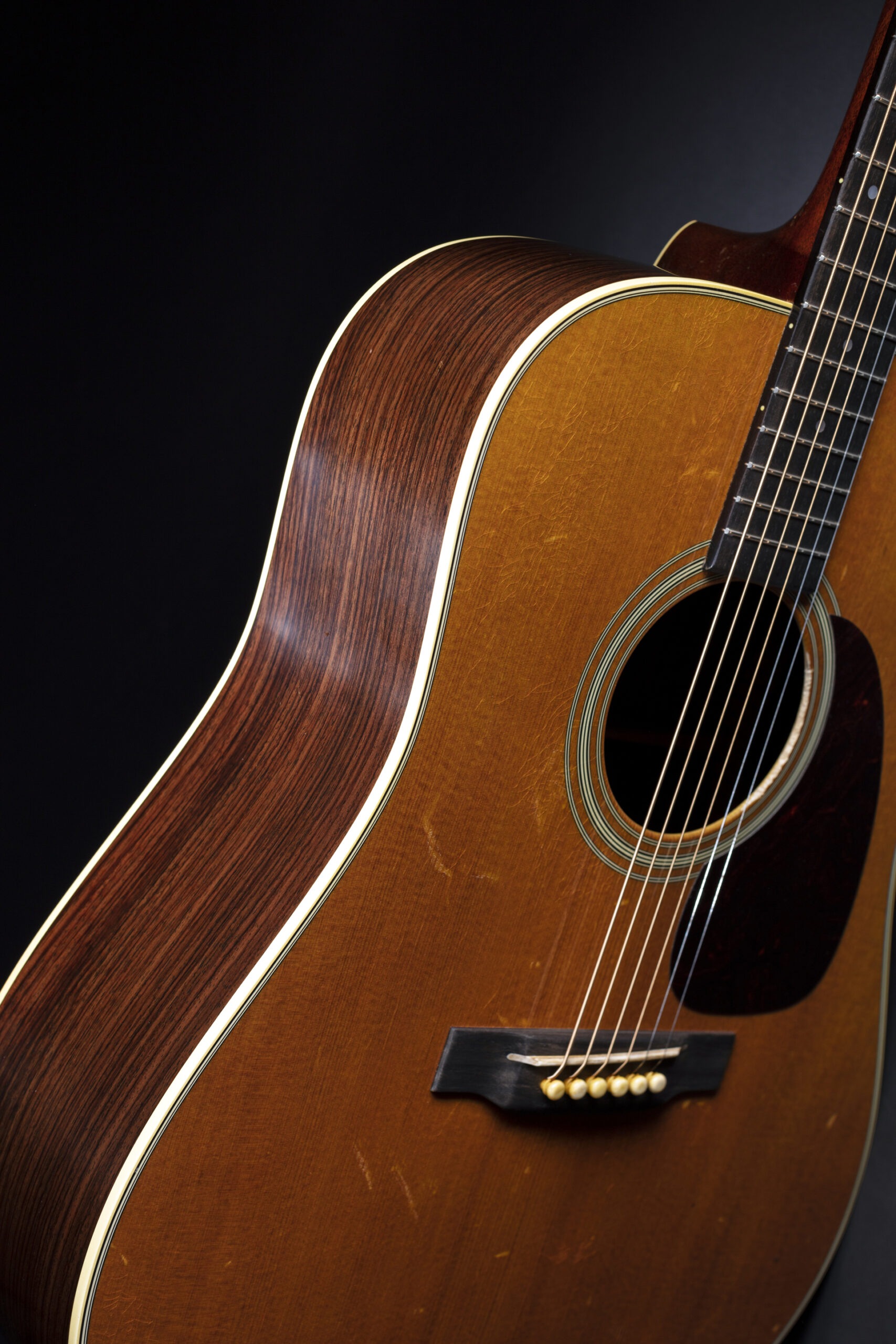 |
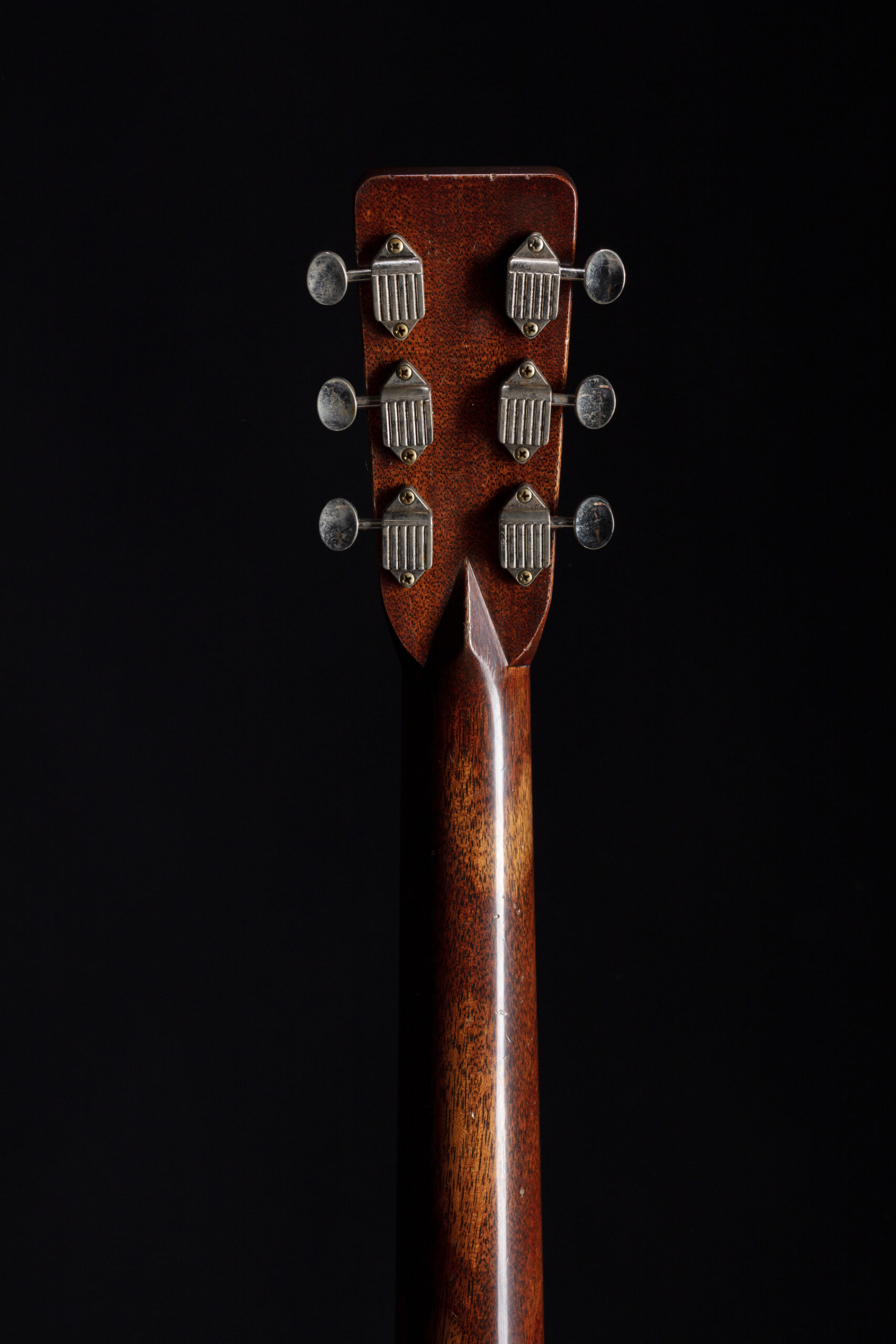 |
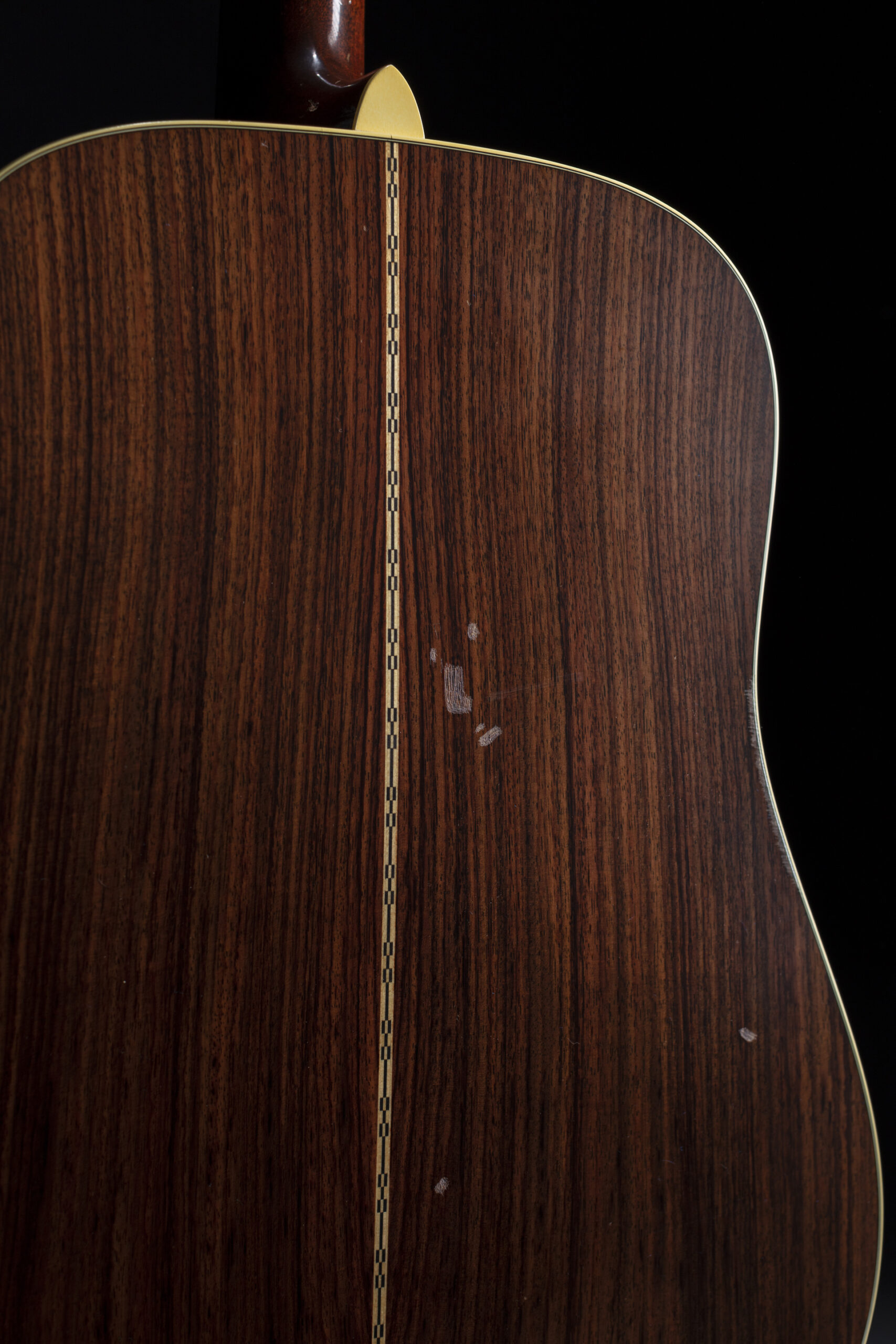 |
click to enlarge
I believe part of the reason the resonance is so pronounced has to do with the use of traditional hot hide glue for all joinery. Martin will not comment on the affect of hide glue on tone. But in any case, this is one full-throated thoroughbred Martin. The coupling of that immediate fundamental pop to the languid swell of the undertone, finished off by those complex, hovering and angelic harmonic overtones makes for a voice that is, in a word, delicious.
This bracing position allows the top to withstand greater physical “attack” from the player while retaining the clarity and integrity of the fundamental notes. Having non-scalloped bracing increases this characteristic. The guitar can absorb tremendously powerful strums which get converted into a power-packed voice of great volume, without the fuzzy distortion often heard from guitars with scalloped bracing and especially forward-shifted bracing. When picked, fingerpicked, or strummed lightly the fundamental notes stand out and are heard clearly, even when supported by such a robust undertone.
The soundboard back in 1954 was Sitka spruce. Today, the D-28 Rich Robinson may have a top of Sitka spruce or Lutz spruce, a hybrid of Stika and White spruce that is considered interchangeable with Sitka. Environmental concerns in the coastal forests of Alaska have compelled the government and wood harvesting companies to move their operations further inland, where Sitka is interspersed with Lutz, which would take an expert botanist to tell the difference between the two.
Quite a Neck
The shaping of the neck was closely copied from the Robison’s 1954 D-28. This is not the 1955 style V neck used on the old D-28 Hank Williams and the C. F. IV Martin commemorative 1955 models. It has a thicker, rounded barrel with a noticeable V that is not as pronounced as something like the Authentic Series instruments with a 1930’s style shaping. Compared to the modern High Performance neck it is quite a handful, particularly in the upper frets.
This must be the most robust neck barrel currently offered at Martin, with only the ginormous neck on the D-45S Authentic 1936 being deeper and stouter. Yet, the Robinson model still has a 1-11/16” width at the nut, so it is easy enough for even smaller hands to reach around in the basic cowboy chords area of the first three frets. But larger hands or longer fingers will likely be most at home when it comes to playing higher up the neck.
Custom Bridge
Rich Robinson requested a change from his dad’s guitar, or other Martins for that matter. He likes to rest his picking hand on the bass side of the ebony bridge and asked Martin to make the contour of the bridge softer, so there is a gentle slope rather than an edge where the bridge transitions from the raised area of the saddle to the lower height of the extended wings. I would be happy if Martin adopted that feature on every guitar they make.
The Black Crows hatched in 1984, in Atlanta, Georgia, and soared to stardom in 1990. Rich Robinson and brother Chris have retired and reformed various lineups of the band for touring and recording multiple times well into in the twenty first century. Rich continues to create new music with his 1954 D-28 and was thrilled to have Martin recreate it for this unique Custom Artist edition, and so too will lucky owners of this model be thrilled by its accurate historical appointments, full yet clear tone, and its signed and numbered label in the sound hole.
And that is one man’s word on the Martin D-28 Rich Robinson
$6,999.00
More Photos HERE
Official D-28 Rich Robinson Spec Sheet HERE
